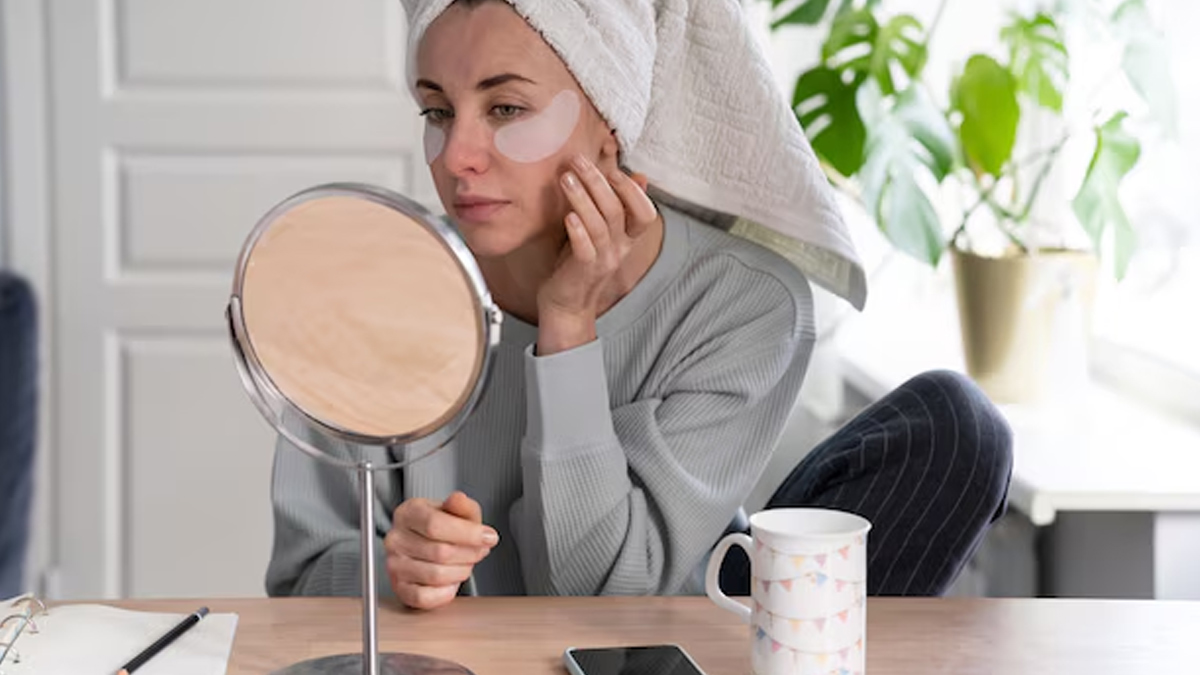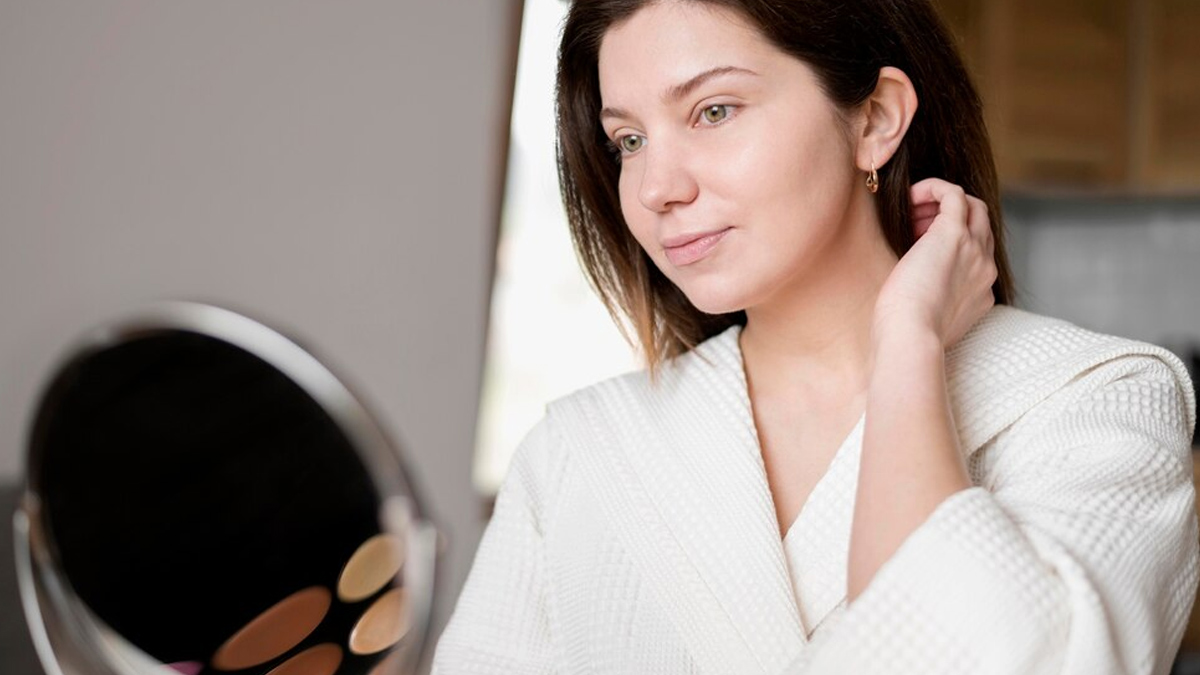
Your skin, the largest organ of your body, acts as the outermost protective layer that safeguards you from external harmful pathogens, Ultraviolet (UV) radiation, and pollutants. In addition, the skin is also a visible indicator of underlying health issues, which can be detected through regular self-examination. A routine self-exam can help you monitor your skin for any changes such as new moles, discolouration, or unusual growths. It not only helps spot early signs of ageing but also helps catch severe issues like skin cancer, which are often overlooked. However, it is crucial to know how to perform a skin self-examination and how often to conduct it. Read to know what our experts have to share.
Table of Content:-
Also Read: Prebiotic For Skincare: Here’s How Prebiotics Can Help Improve Your Skin Health
How Often Should You Self-Examine Your Skin?

The frequency of your self-exams depends on the specific skin concerns you’re monitoring,” Dr Geetika, Dermatologist and Founder of Influennz Skin and Hair Clinic, Delhi, told the OnlyMyHealth team.
For skin cancer and moles, skin examinations should be an annual routine. "A yearly full-body skin check is essential to monitor for any suspicious moles or changes in existing ones," Dr Geetika said, adding that skin cancer often starts with changes in moles or new growths, so this step is critical.
Ageing is a natural process, but early signs can be addressed with the right skincare routine. A yearly routine can help check for signs, such as fine lines and wrinkles, especially around the eyes, mouth, and forehead; sagging skin or a loss of elasticity in the cheeks, jawline, or neck; and double chin or drooping mouth corners, often linked to reduced collagen and elasticity.
To check for sun damage, self-examination should be conducted once every three months. Monitor for dry, dehydrated patches that don’t improve with moisturisers, prominent veins or capillaries, especially on the nose and cheeks, and sunspots or age spots, which appear as small, flat, darker patches on sun-exposed areas like the face, hands, and shoulders.
Every six months, you can also self-examine your skin for pigmentation, which can develop over time, often exacerbated by sun exposure, hormones, or lifestyle factors. These issues often include melasma, which presents as dark, uneven patches, often on the cheeks or forehead; tanning that doesn’t fade evenly or seems excessive; and dark circles under the eyes, which may indicate stress, lack of sleep, or deeper pigmentation issues.
One of the most common skin issues is acne and comedones, which should be checked every two weeks. A biweekly checkup can help prevent worsening of issues like whiteheads, blackheads, and active acne, especially on the face, back, and chest.
Signs Of A Healthy Skin Versus Warning Signs

Speaking with the OnlyMyHealth team, Dr Varsha M Shetty, Associate Professor, Department of Dermatology, KMC, MAHE, Manipal, shares distinguishing factors between healthy skin and skin that has concerning issues.
Signs of a healthy skin:
- Even tone and skin texture
- Smooth and soft skin, without excessive dryness, scaling, or flaking.
- Soft and supple skin, with an even distribution of oils (not too oily or too dry).
- No unusual blemishes, persistent acne, or unusual marks.
- No pimples, whiteheads, or blackheads that occur occasionally
- Firm, elastic, and resilient skin, bouncing back when gently pinched (a sign of collagen and moisture levels).
- No excessive wrinkles or fine lines, though some natural ageing may occur.
- Adequate hydration and moisturisation of the skin
Potential warning signs to watch out for:
- Changes in moles and spots
- Persistent redness or inflammation in the skin
- Skin itching or pain
- Skin dryness and flaking
- Discolouration
- Blisters/ulcers
- Unusual growths on the skin
Also Read: Reducing Your Risk of Melanoma: Lifestyle Changes That Can Make a Difference
How To Perform A Skin Self-Exam

The ABCD rule is a simple way to evaluate moles for potential issues:
- A - Asymmetry: One half of the mole doesn’t match the other in shape or size.
- B - Border: Irregular, blurred, or jagged edges are a red flag.
- C - Colour: Uneven colouring or multiple shades (black, brown, red, white) can be concerning.
- D - Diameter: Moles larger than 6 mm (about the size of a pencil eraser) warrant a professional check.
If you notice any of these signs, or if a mole itches, bleeds, or changes rapidly, it is recommended to consult a dermatologist immediately.
Do Not Skip These Skin Areas
When it comes to examining your skin, your face isn’t the only area that should be checked. Instead there are areas in your body that may often get overlooked. These include:
Breasts: Check for lumps or changes that might indicate fibroadenomas (benign growths) or more serious conditions like breast cancer.
Back: Since the back is hard to see, it’s often ignored. Use a mirror or ask a partner to help you check for new moles, rashes, or acne.
Underarms: Look for lumps or boils, which might be cysts or enlarged lymph nodes.
Vagina: Pay attention to changes in vaginal discharge, which can indicate infections or hormonal imbalances.
Scalp: Use a hand mirror to examine your scalp. Part your hair to check for unusual moles or spots.
Torso and limbs: Stand in front of a full-length mirror and examine the front, back, and sides of your body. Use a hand mirror to look at the backs of your arms, legs, and thighs.
Palms and soles: Check the palms of your hands, the soles of your feet, and between your toes for any unusual spots.
Nails: Examine the fingernails and toenails for any changes in colour, shape, or texture.
Genital area: Carefully check your genital area for any changes or unusual marks.
Conclusion
Self-examination of the skin is a great way to spot unusual growths and moles that may often signal severe skin-related issues, including skin cancer. It is important to be aware of your body, including your skin, and address any changes. Consult a dermatologist or a doctor if you notice any irregularities or abnormalities.
Also watch this video
How we keep this article up to date:
We work with experts and keep a close eye on the latest in health and wellness. Whenever there is a new research or helpful information, we update our articles with accurate and useful advice.
Current Version
